“I have a British background and I have always had tea and something sweet. First time I tried this clotted cream I almost ate the entire jar by itself, it is that good!” ~Kim

If you’ve never had a classic English afternoon tea with scones and clotted cream, you’re missing out!
Last week I was treated by the historic Biltmore Hotel in downtown Los Angeles to their classic English afternoon tea. If you’ve never had a classic afternoon tea, you need to experience it. The highlight of any afternoon tea, besides the tea, is the array of tiny treats that comes with it, and I always zero right in on the scones and clotted cream. (That’s them on level two of our 3 tiered tea tray.)

What is Clotted cream?
If you’ve never had it, clotted cream is a very thick rich spreadable form of heavy cream that was first invented ages ago by some very smart British farmers. Traditionally cream heated until it thickens and develops a slightly nutty flavor. Clotted cream has a high fat content (around 55-65%) and a dense texture. It’s not like whipped cream, or cream cheese, it’s not like butter…it has a unique decadent consistency and a wonderful soft flavor. It’s quite thick and spreadable, and when you slather it on a freshly baked scone there is no better thing in the world.
The little pot of clotted cream that we got at the Biltmore had me craving more, and happily I made the most astounding discovery…you can actually make clotted cream at home in your own kitchen. No more tracking it down in specialty stores and paying big bucks for the imported stuff. My homemade clotted cream was actually way better (and a whole lot fresher) than the British stuff I usually buy.

What does clotted cream taste like?
Clotted cream has a rich, creamy taste with a slightly nutty ‘cooked’ flavor. It’s luxurious and indulgent, with a dense, velvety texture that is thicker and creamier than regular whipped cream. Clotted cream is also slightly sweet, but not as sweet as whipped cream or frosting, with a delicate flavor that pairs well with desserts, fruit, and scones. The crust on top of the clotted cream adds a slightly caramelized and nutty flavor, which many people find particularly delicious. The mouthfeel of clotted cream is a key part of its charm, and is like nothing else you’ve ever had!
what you’ll need
- heavy or whipping cream that has not been ultra-pasteurized
- This is cream that has been pasteurized, but not ultra-pasteurized. Ultra-pasteurized cream is cream that has been heated to a higher temperature than regular pasteurized cream to extend its shelf life.

How to make clotted cream
This is an amazing process, I hardly had to do anything, and I end up with a ton of the richest, silkiest clotted cream I’ve ever had.
- I used 2 pints of (non-ultra-pasteurized) heavy cream.
- I poured them into a baking dish, and left it overnight in a 180F oven (the lowest my oven will go.)
- In the morning I let it cool and then refrigerated it for the rest of the day.
- Then I scooped it into jars, which was a little sloppy at first, and put them back in the refrigerator. Any little bit of liquid gets absorbed right into the clotted cream after you put it in the jars, and by the next morning when I had it with my scones, it was absolutely to die for.
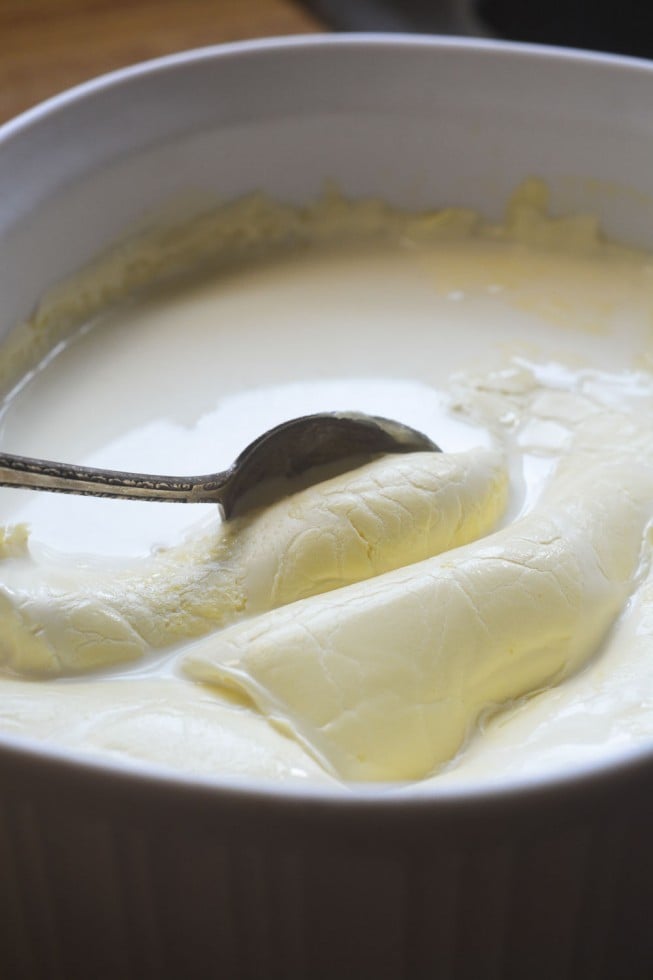
How long does clotted cream last?
Homemade clotted cream can last for up to 3-4 days when stored properly in the refrigerator. To extend its shelf life, it’s important to keep it in an airtight container and store it in the coldest part of the refrigerator, such as the back of the bottom shelf.
It’s important to note that clotted cream does not have any preservatives, so it should be consumed as soon as possible for the best flavor and texture. If you notice any changes in color, texture, or odor, discard the clotted cream immediately as it may have spoiled.
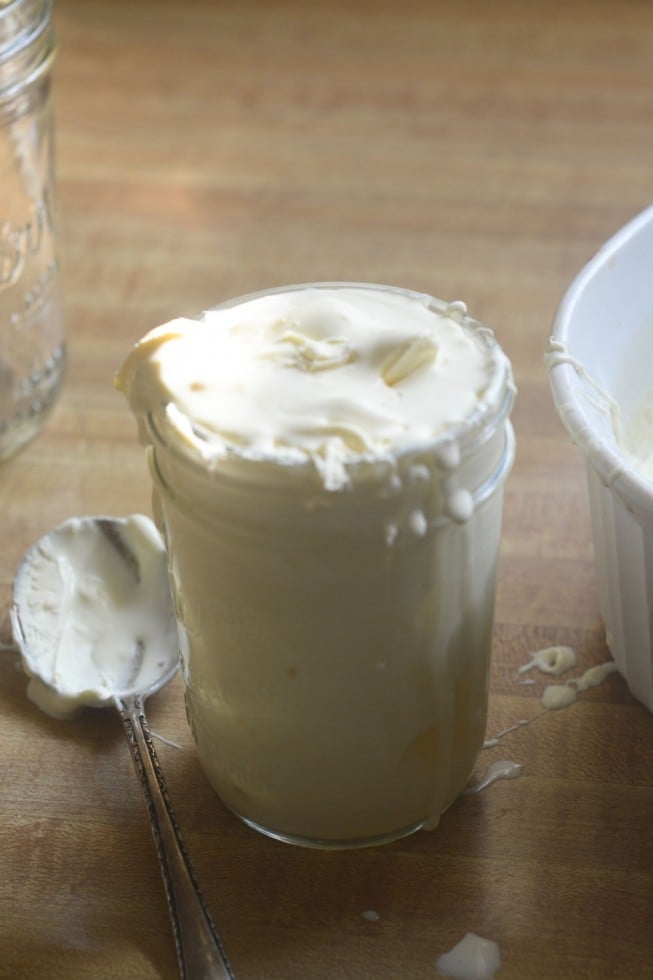
What to do with the leftover whey from making clotted cream
The leftover whey from making clotted cream can be used in a variety of ways:
- Adding it to smoothies or protein shakes for a boost of protein and nutrients.
- Using it as a substitute for milk or water in baking recipes such as bread, muffins, and pancakes.
- Using it as a marinade for meat or fish to tenderize and add flavor.
- Adding it to soups or stews for added richness and flavor.
- Using it as a liquid base for making homemade ricotta cheese or other soft cheeses.
- Feeding it to pets, as it is a good source of protein and nutrients for animals.
Note: It’s important to keep in mind that the leftover whey should be used or stored promptly to avoid spoilage. It can be stored in the refrigerator for up to a week or frozen for longer storage.
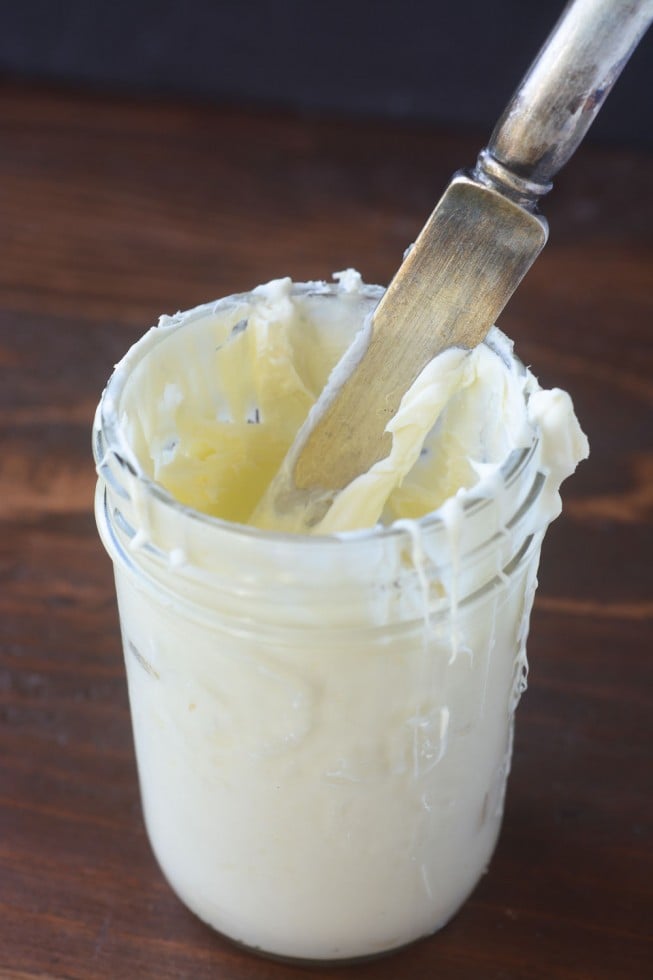
I can’t say enough good things about this project, the results far exceeded my expectations and it was absurdly easy. The only catch is that you can’t use ultra-pasteurized cream, which is cream that’s been processed for a longer shelf life. Many stores only sell ultra-pasteurized cream, so you have to search a bit for regular cream. I found mine at Whole Foods. Just read the labels… if it doesn’t say ultra-pasteurized on the label, you’re good to go.
can you make clotted cream with ultra-pasteurized cream?
Some readers in the comments below have had success with ultra-pasteurized cream. It is possible to make clotted cream from ultra-pasteurized cream, but it may be more difficult to achieve the desired texture and flavor. Ultra-pasteurization is a process that heats the cream to a higher temperature than regular pasteurization, which extends its shelf life but can also alter the proteins and enzymes in the cream. This can make it more difficult for the cream to form clots, which are necessary for making clotted cream.

What to eat with your homemade clotted cream
You will definitely want to make scones to go with your homemade clotted cream. I have lots of recipes for scones on the blog, but a simple one to start with is my Classic Cream Scones Recipe.
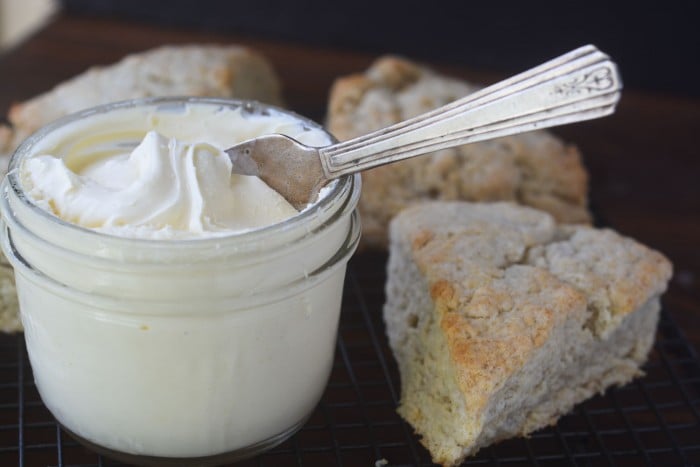
Tips for making clotted cream
- Make sure your cream is not ‘ultra pasteurized’, you will need to find regular pasteurized cream at a Whole Foods or other similar store. Ultra pasteurized cream has been treated in a way that prevents it from ‘clotting’.
- An oven thermometer is an essential kitchen tool, and really comes in handy for this project. If your oven is too cool or too hot your homemade clotted cream will not ‘clot’. Set your oven to 180F and then check the thermometer. You can adjust up or down as necessary.
- If your oven does not go down as low as 180F you can try one of my other methods for making clotted cream:

Homemade Clotted Cream
Video
Equipment
- a heavy casserole dish
Ingredients
- 2 pints heavy cream or whipping cream (double cream in the UK), avoid ultra-pasteurized cream for best results.
Instructions
- set your oven to 180F
- Pour the cream into the casserole dish. It should come up about 1-3 inches on the side.
- Set the dish, uncovered, in the oven and leave undisturbed for 12 hours. Be sure to leave the oven on the whole time. I do this overnight.
- Remove the dish from the oven and set to cool. Then cover and refrigerate. Note: the cream may seem thin at this point, but is going to thicken considerably overnight.
- The next morning scoop the thickened cream into a jar or jars, and cover and put back in the refrigerator. You can use the leftover cream for baking..
- Spread the clotted cream on freshly baked scones.
Nutrition


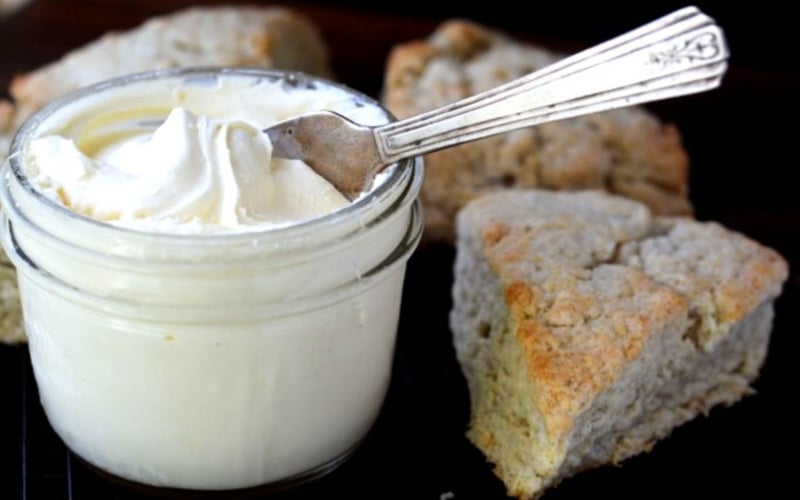












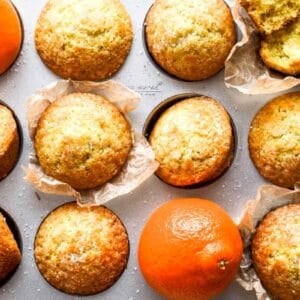







Real clotted cream as found in the U.K. does have a crust, it’s delicious and buttery. You should not stir the cream back into the whey before refridgerating. After it has cooled from the oven gently put the container into the fridge being careful not to shake for a few hours or overnight. Then scoop the cream off the top with a slotted spoon from the liquid whey underneath. The whey can be reserved for other uses. Then gently stir the cream before putting it into an air tight container, like a mason jar.
My clotted cream is currently in the oven as we speak! I’m wondering if you have any recommendations on recipes to use the leftover liquid cream in or if it would be good to just throw in the bread maker as a water replacement? Thank you!
Good question, Danielle ~ I don’t know but I’m hoping another reader will weigh in!
I would use it in any recipe that calls for buttermilk…..works in every whey ???
I just got back from England and fell in love with clotted cream. I just made this and while it rated delicious it doesn’t have that velvety smooth texture and isn’t very spreadable. I did not leave it on the fridge over night, just from morning to evening. Could my fridge have been to cold? I want that velvety texture so bag! Any recommendations?
Hi Monika ~ did you stir the liquid and thickened part together? Be sure you don’t discard the thinner stuff after it comes out of the oven…that should loosen it up and make it the perfect consistency.
I didn’t discard it until I was ready to jar it. But I didn’t mix it together. Am I suppose to?
Yes, you should stir it all together. Then refrigerate, and while it chills the whole thing kind of meshes together.
It doesn’t say anything about stirring in your recipe. Do I stir it after removing it from the oven and cooling, before I put it in the frig over night? Or do I frig it overnight and then stir it before putting it into jars? Confused…
It’s sort of a stir if needed kind of thing, Deann. I would first refrigerate it and see how thick it gets, then you can stir it together before bottling it.
Oh sue…..after reading all the recipe and comments you have just completely thrown me……you didn’t say to stir it at all…infact you said the opposite….thats why in another comment I said to use the remaining liquid as you would buttermilk…..im now unsure how to make it.
Please post this comment as its an important step for others.
I think the real answer is that the results will vary quite a bit from person to person, so some might stir and some might not. If you just skim off the thick top you’ll wind up with a very thick clotted cream, but if you are left with some liquid you can also mix it in, and it will firm up as it chills.
Where do I get non ultra pasteurized cream? Is there anything I can use instead of that?
Unfortunately it has to be unpasteurized. I found mine at Whole Foods.
Another person’s instructions said that I should cover my cream as it was cooking. Yours said to leave it uncovered. Any chance I’ve ruined it, if I covered it?
I don’t think so, Leigh Anne, but I can’t say for sure…
While a fan of the original in Devon no less, I’ve found Mascarpone cheese (Tubs in CostCo) to be a phenomenal ready-to-eat alternative.
I will be hosting my book club in June. The book we read takes place in 1800 England. I am going to have a high tea to recognize this culture. I have never made clotted cream, but had it once in England and it was delicious. I have jars and jars of homemade strawberry jam prepared with berries from my garden. Delicious. I have lots of time to practice. I have never made scones either, but I am a good baker. It’s fun researching all the different recipes. That’s how I found you! I have extra cream in my refrigerator now from Christmas, so I am going to practice very soon. Thanks so much!
Have fun Julie!
Sue, does the size of the container matter that the cream is made in?
Yes, it does, Coleen, and it’s a little bit of an inexact science, unfortunately. You want the cream to be at a depth of about 2 inches.
Hi Julie, you want to host an “Afternoon Tea” which was done by the aristocracy, royalty and any other lady of high repute.Tea was served between 3 and 5pm, as dinner was not served until about 8pm at night. A “High Tea” was utilized by the working class when they arrived home from the farm or work around 6pm or 7pm that was basically their dinner with heavy meat entree, potatoes,stew–that was served with tea. Also, High Tea was not popularized until about 1840, so Jane Austen, according to her sister Cassandra, she and her family had tea in the morning and before bed. Jane’s family duty was to making tea every morning for her family and Jane held the keys to her family’s
“Tea Chest” as tea was so expensive, it was always kept locked up so the servants could not steal it.
Almost right! Tea, High Tea, and Afternoon Tea are all different. The usage does alter with social class but also with where in the country you live. “Tea” as a meal time is used in the North of England to refer to the evening meal or dinner there is no “entree” or “starter” to this although the meal would be sustaining and would possibly have a pudding afterwards. In the south of England High Tea is referred to mostly for Sunday afternoons when Sunday lunch has been the main meal, High Tea would then consist of perhaps cold meats, hard-boiled eggs, bread and butter, salad, pickles. Afternoon tea as you said would be dainty, small sandwiches, small cakes and pastries, scones or tea bread and jam. Although this tends now to be a tourist event or treat it can still be found in it’s entirety as a Cricket Tea throughout the land! I would recommend anyone who visits England from April to the end of September to look out for a cricket club- there you will find all the traditional baking of whatever region you are in- not the tourist hotel formats (although they too are delicious) or search out the local W.I. market. (I have made cricket teas for 30 plus years!)
I might add a section in this post about the different definitions of tea time…thanks Jacqueline!
So, I’ve tried this 4 times, and each time it’s had to go in the bin. I’m using an oven thermometer and monitoring it, so I know it’s not the temp, and I’m using heavy cream (pasteurized). It gets an orangey brown on top, which turns the cream underneath beige. It’s the wrong colour, and has a funny caramel taste to it (sort of burnt). The last attempt was the most successful (better cream), but I’d say I got less than a quarter of a jar that’s thick (and it tastes funny anyway). Any other ideas what could be going wrong? Clotted cream is one of the only things I miss from home!
It sounds like the temp is too high, Rachel, it shouldn’t be an orange-y brown, or smell burnt at that low temperature. Is it possible you have the cream in too large of a container?
Seems that everyone has commented on your clotted cream. I have never had the pleasure to taste it on a scone, but it looks like something I must try. My comment is on the filling of your jars! You said it was messy (yup, it was according to your photos). Just get yourself a canning funnel. It has a wide “funnel” part – perfect for filling jars. I have 2 in my kitchen and they are always in the dishwasher from use. Handiest tool ever.
smile.amazon.com/Norpro-Mouth-Plastic-Funnel-Green/dp/B000HJ99XS/ref=sr_1_2?ie=UTF8&qid=1479130663&sr=8-2&keywords=canning+funnel+for+wide+and+regular+jars
Your recipe is intriguing! I am going to try this although my oven doesn’t have a setting below 200F- it just says “warm” so I’ll try making it on “warm’ for the 12 hours. I learned to make clotted cream a bit differently from a friend while I was visiting her in England. In a low sided saute pan- (NOT a sauce pan- it is much easier to scoop out in a saute pan and you have more surface area for the cream to “clot”) pour in a pint of cream and put the burner on a very low setting. When a skin forms on the top- gently scoop it off and collect in a jar. Continue to do this until the cream is gone. The clotted cream will seem partially congealed with watery appearing cream around it but no worries! Just mix it back in with the clotted cream and when finished- refrigerate. It will thicken up in the fridge.
I have made clotted cream this way for years and it has always come out wonderful. The whole process takes me about 30 minutes and there is no leftover cream.
Thanks Tamara, I’m interested to try your method!
Hi Tamara
How long does it take for a skin to form?
Tamara, I have tried your hob top method and wow it is fantastic! No waste and took a bit of time and careful skimming but the preliminary results looks promising. I can’t wait until tomorrow to taste it!